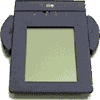| g e n u i n e i d e a s | ||||||
 |
 |
 |
 |
 |
 |
 |
| home | art and science |
writings | biography | food | inventions | search |
| airwriter |
|
In the early 1990's, AT&T uncharacteristically decided to lead the market by designing and selling its own wireless personal digital assistants (PDAs) and communicators. They developed the EO, based on a version of the General Magic pen computer- but the timing was premature, and neither ha At the same moment, my lab was developing a number of forward looking consumer products, like the AT&T Wrist Phone. Personally, I felt most of the hyped pen computers offered little utility or excitement beyond mere novelty, so we set out to design a new product concept from scratch. Jealousy and hubris are powerful motivators... This was the "Airwriter". Coincidently, our lab helped sponsor and judge a nationwide student contest in 1993 to invent the most interesting PDA- their ideas were truly innovative. Unfortunately, with the demise of the EO and after AT&T sold its "non strategic" Consumer Products Division to Philips Electronics in 1997, the Airwriter project languished. A few elements of its underlying technology were patented (see below), and I just rediscovered this video demonstration in a box of old VHS tapes. Despite the poor image quality, the general concept is clear. The original software was prototyped in Supercard on a mac, from late 1992 through 1994. Many of these ideas are only now appearing in commercial products, such as the Apple's iOS, Windows Mobile, and google's android-- once again demonstrating that invention has many parents but few children. ; The Metaphor The Fridge: Many people use their kitchen refrigerator as a family message board, calendar, photo album and receipt organizer. So, I co-opted this familiar behavior as a metaphor for a new wireless PDA- right down to the magnets and door handle. Remember, this was late in 1992, and cell phones were still rare and clunky and almost everyone was reliant on dial-up modems. Magnets: Each application took the form of a "magnet" that stuck to the refrigerator's front door. Clicking on a magnet caused the others to temporarily disappear, while launching a full screen application. Magnets could be purchased and downloaded wirelessly, or sent and shared with other Airwriters. We hoped kids would collect and share magnets like they traded baseball cards. While some magnets contained serious office applications, such as email or calendaring, others were delightfully pointless time wasters. Security: The processor architecture anticipated an occasional viral infection because of the ability to share magnets- and provided for a clean and safe partitioning between trusted and unknown applications. An infected Airwriter could be reset to a safe baseline with the flick of a button- US 5802275. Also, the user could lock the Airwriter with a "graphical password", where they clicked on a sequence of points within an image, rather than entering an alphanumeric string. US 5559961 Navigation: The Airwriter incorporated a touch screen interface- operated with either a stylus or finger. Our group co-developed a number of very capable capacitive touch screen technologies- including both multi-touch and pressure sensitive membranes-- more than a decade before the iPhone- see US 5113041 and US 5463388. In fact, the successor to the Newton tablet would have licensed one of these patents, but Steve Jobs (correctly) cancelled the Newton line when he returned to Apple. Located on the right side of the fridge (as either virtual or physical buttons), are a number of important functions- such as undoing the last action, context sensitive help, emergency 911, "SEND", "next page", etc. In addition to the touch screen and navigation buttons, I (re)invented the idea of a cursor menu. Basically, by tapping on an open area of the screen, the cursor was surrounded by a ring of context sensitive functions- for example, delete, copy, move, mail, paste, etc. Sliding the cursor in the direction of that item temporarily adapted the the cursor to that function. We expected text would be entered via handwriting recognition or a popup or built-in keyboard. A similar idea was developed for cell phones- using a mechanical "venetian blind" display to change from numeric to alphabetic keyboards. Applications Wireless commerce: The Airwriter demonstrated four financial applications. It could receive coupons from a store (in this example, McDonalds) and then wirelessly redeem the coupon at the store. It could wirelessly pay for a meal- drawing funds from an internal "ATM" with stored value, or a credit card. It could send funds to other Airwriters. And it could monitor and approve credit card charges. US 5708422 It could also track it's location off cell-towers, and use that information to develop traffic maps or geofence e-commerce. All back in 1994. Email: The Airwriter received messages via "push" technology on a real-time basis. Those messages might contain voice mail, text, handwritten images or even additional applications. Outgoing messages could be created in any magnet by using the cursor menu, and the software would automatically select a recipient via the address book. New messages were queued under the "out" magnet. We suggested each message required an explicit push of the "send" button, to provide the user with a last minute opportunity to modify or erase the missive. Utilities: Stopwatch, clock, the 1990's cliche "take out pizza" application, voice recording, phone, calendar, etc.
|
Contact Greg Blonder by email here - Modified Genuine Ideas, LLC. |
